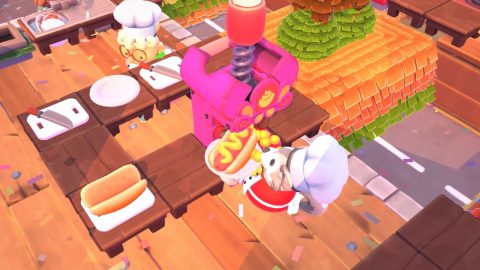
As one of the all-time classics, Resident Evil 4 has come to every platform since it originally launched in 2005 as an exclusive for the GameCube. While the Wii edition added motion controls into the mix, it’s still essentially been the same game that fans have known and loved. Resident Evil 4 VR however is the first iteration to make Capcom’s masterpiece feel fresh once again for both old and new players.
Who better to bring Leon S. Kennedy’s adventure through nightmarish rural Europe to Oculus Quest 2 than Armature Studio, a developer founded by former members of Retro Studios who also came to prominence in the GameCube era as the team behind the Metroid Prime series. Having the opportunity to speak to Resident Evil 4 VR’s senior producer Tom Ivey, it’s clear he has just as much reverence for Resident Evil 4, and could see why it just made a perfect fit for VR.
“To begin with, It’s an action-oriented game, so it kind of fits a little bit more than some of the earlier [games in the] franchise,” he says. “But Resident Evil 4 was also the cornerstone – it was an introductory game for a lot of people, and so in the same way, being an introduction for the VR experience we thought was a good match.”
If you were going to pick one perfect game to adapt for VR, then Resident Evil 4 is surely the one, packed with so many outstanding set pieces and environments that most modern games fail to come close to matching. “I think everybody remembers the first village, and when the chainsaw guy comes out, there’s just this visceral feeling to playing that experience,” Ivey continues. “With VR, you can just take everything that was great about Resident Evil 4 and just try and magnify it as much as possible.”
While Resident Evil 7 was the first game in the series made playable in VR, Resident Evil 4 VR is a complete from-the-ground-up adaptation to VR, shifting from the original third-person over-the-shoulder perspective (itself game-changing at the time and copied by countless games since) to a first-person view that truly transports you into the game. To the undiscerning eye, it looks just like the original game. But while Ivey confirms that the VR game does essentially run on the same code, graphically it’s been remade from scratch in Unreal Engine. Still, this isn’t meant to be a remake (that one is still on the way from Capcom) but rather designed as an “HD VR-ready version”, as Ivey puts it.

“No matter what we do to modify this in VR, the player has to be like, “Yeah, this is what Resident Evil 4 looked like”,” he adds, although the team didn’t simply dump GameCube assets into the Quest 2, something fans have often complained about subsequent HD ports recycling the same dated textures.
“Because you can get your face up to every texture in this game, you would notice when it’s a GameCube texture,” Ivey laughs. “So we went up four times, sometimes eight times the resolution of the original textures, recreated from scratch, but always looking at the GameCube source as the reference for what we were making.”
Some objects, such as candelabras, also had to be made from scratch because they only existed in a 2D plane in the original game, which in VR would immediately “look weird and ridiculous”. The fact that you can now poke your head into spaces and angles you couldn’t before also meant having to add more to fill in the blanks. The most drastic changes however come from puzzles, as well as doors and levers, which are now all physically interactive instead of just pressing a button (unless you’re pushing a physical button in front of you).
This is the same with all of Leon’s weapons and inventory, which can all be held physically in your hands to be examined, while guns have to be manually reloaded and other equipment like grenades and the knife are strapped to his body.

“It was all about taking every aspect – the environments, the enemies, the story – and making you experience it as if you’re actually there,” Ivey explains. “So you’re looking down at your weapon, you’re pulling out of an ammo pouch, loading the clip, popping the clip. Same with puzzles and doors, you’re physically grabbing and pulling them – we wanted to transform as much of the game as possible in that way while keeping all the actual gameplay the same.”
Although physicality feels integral to experiencing Resident Evil 4 VR, there’s also a wealth of options for playing it. While grabbing equipment from your body does feel optimal, you can also access them via a click wheel; quick time events that have been adapted into motion controls can be skipped entirely (including that memorable yet stressful knife fight with Jack Krauser); then there’s a wide range of comfort options, whether you want to play with smooth or snap movements, room scale or teleport, standing or sitting. You can even strafe and shoot in this version, something purists like myself would probably find sacrilege, though fortunately you can also opt for ‘classic Leon’ controls.
Either way, Ivey doesn’t believe these options necessarily make the game too easy. “What we really found was, maybe I can strafe and can avoid things easier than before, but because I have to physically remember to load the weapon, load a new clip, I have to be cognizant of my timing on that,” he says. “That moment-to-moment thought process you have to do, or the narrowness of your vision in first person, balanced out fairly well in terms of what you gained and what you had to deal with additionally from that perspective.”
Ultimately, the aim was that no matter which set-up the player goes for, the controls aim to make players feel cool and just like Leon. Yet there is one particular distinction, Resident Evil 4 VR takes from other first-person VR experiences such as Half Life: Alyx, which is that you’re not always viewing the scene through Leon’s eyes. This isn’t limited to cutscenes, which just appear as a theatre screen in front of you, but you’re also snapped out of the action for interactions such as when Leon is pushing a shelf, kicking a door down, or roundhouse kicking a stunned enemy.
While it can show up the limitations of the VR port without an extensive rework, Ivey say this is intentional. “This is an important conversation we had with Capcom and Oculus – how much are you being Leon, and how much are we still showing Leon the character doing these cool moves?” he continues. “If you’re suplexing an enemy or kicking them, we don’t have a leg come out of your body, we pull the camera out, show you doing that cool move and then pull you back in. It was very important to make sure that you’re still actually playing Leon.”
Ultimately, you’re still grounded in Resident Evil 4 VR’s world, thanks to the hundreds of physical interactions incorporated into the game, which Ivey was responsible for scheduling and prioritising. “I was like, let’s put all the biggest moments at the top that we’re definitely going to do, and if we have time, we can get to those all the way to the bottom of the list,” he says, proud that the team did in fact include every interaction planned, including physically opening a bear trap to rescue a dog, a memorable scene that resonates even more now than pressing a button.
“Hopefully, when everybody gets to play it, they’ll be glad with what we were able to do. This isn’t a partial port, this is a full VR version of this game in every way that we could possibly make it.”
Resident Evil 4 VR launches for the Oculus Quest 2 on October 21.
The post Armature Studio on bringing ‘Resident Evil 4’ to VR appeared first on NME.








